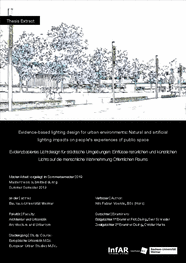
Evidence based lighting design for urban environments
Master Thesis by Nils Voerste
Study Programme Integrated Urban Development & Design
2019
In this Master Thesis Nils Voerste investigates how lighting affects pedestrians experience on public squares.
People’s perception of the surrounding urban environment is vastly shaped by its spatial composition through boundaries, surfaces and light. Therefore, the design of lighting in public places plays a profound role in how users interact with and within it, ranging from tasks such as: navigating and using urban space to perceiving its social structures. Public places that provide an urban setting and spatial ambience
that improve these tasks, can create a state of heightened pedestrian comfort.
Having investigated both illumination and spatial configuration from three different public places (Goetheplatz in Frankfurt, Herderplatz in Weimar and King’s Cross Square in London), the author compared results of eighteen scenes by using a combined lighting (luminance distribution and lighting comfort) and spatial analysis (isovist visibility) together with findings from a questionnaire on people’s perception of comfort within each of the public places.
Results from this study show that places of detailed lighting strategy, focussed on creating spatial and socially legible space improve overall pedestrian comfort, even in complex urban scenes.
Keywords: Environmental Psychology, Public Squares, Lighting Design, Spatial Cognition and Perception

